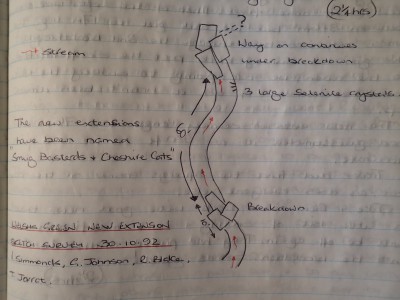Welsh’s Green Swallet [NGR ST 5506 4771] is something for the connoisseur. A couple of short drops lead to low crawling-size passages with an ample supply of mud, much like caving in liquid cement, there are some tight squeezes to negotiate along the way too. It is, however, probably the longest known cave in the world in Blue Lias Limestone and there are some fine selenite crystals to be seen.
First dug by persons unknown in the 1930s and by Wessex Cave Club in 1961. A new phase of excavation began in 1979, continuing to 1989 when the first breakthrough was made.
During October 1992, there was a period of sustained effort by myself, Graham ‘Jake’ Johnson, Rich Blake and Tony ‘J’Rat’ Jarratt, occasionally aided by others, to ‘push’ the current end of the cave. Eventually, there was a tantalising glimpse into ‘black’ space beyond, it looked good and we were excited.
From my personal logbooks:
28/10/1992 with Jake and J’Rat
Last night’s bang cleared some stuff, one quite large boulder. I still couldn’t
squeeze through, but did get a better look and it does look good, nice strong
draught and what looks to be, hands and knees size passage going away, can only see 8 – 10 feet. Jake was in raptures when he came back from drilling and
charging. We also shifted all the spoil back to the aven. J’Rat, also cordoned
off some fine selenite crystals. Another 1.5 hours trip.
29/10/1992 with Jake and Murray Knapp
Blitz-Krieg strikes again!
After some hammering, chiselling and barring, I finally managed to squeeze through into new passage, 15ft. x 15ft. x 3ft, high. Waited for Jake and Murray to pass through and then exploring brand new cave.

After the squeeze, you enter a bedding plane and then, a T Junction, the right-hand leg closes-down after 15ft., to the left, hands and knees crawling, up to 6ft. wide and very well decorated, leading for about 40ft. to another T Junction.
The left-hand side leads for about 40ft.of crawling, with stal and selenite, to a blind chamber, 10ft. x 5ft. x 3ft., with a dripping crack and nice float calcite on the edge of a pool. The right-hand leg [of the T Junction] goes for about 40ft.to a left turn and then, 15ft. to boulder break-down, some shoring and a bit of work here will lead to another breakthrough next trip. This small passage has the largest selenite crystals I’ve ever seen and some very nice stal and rusticles.
The entry squeeze is going to be left awkward because the whole area contains some very delicate formations. It also makes all the work worthwhile.
30/10/1992 with Jake, J’Rat and Rich
Back for more discoveries!

Didn’t take too long to get to the break-down, this time we had some short scaffold poles for a bit of shoring-up. Jake soon removed, what appeared to be a
chock-stone, and then squeezed through into more spacious open passage. The
way-on continued for about 60ft. until reaching more, big block break-down, Rich managed to get in a further 15ft. to a dig, very squalid as well, so that’s about it for a while.
The new section doesn’t have any stal but, it does have some large selenite crystals.
Following the breakthrough, several surveying trips were made with Trevor Hughes, the new extension survey length was 76 metres, we had guesstimated it as 230ft.(70m), so we were quite close. While we were at it, the entire cave was surveyed.
“…18th November, again on a Wednesday evening. Vince, Jake and myself surveyed 97m of passage that evening. The Compost Corner legs were most remembered – Vince managed, most successfully, to ensure that for virtually every survey station, to read the compass, I had to bung my somewhat hirsute chin into the mud, revenge I suppose for making him do all the outward trip backwards.” (Hughes, 1998).
References
Simmonds,
V.J. Personal logbook 1990 to 1992
Gray, A., Taviner, R. and Witcombe, R. 2015. Mendip Underground: A Cavers Guide (5th Edition). Mendip Cave Registry & Archive
Hughes, T. 1998. Welsh’s Green Swallet – the Survey (Or The Mud-Pile Strikes Back) in Belfry Bulletin, 495 p22-25. February 1998

